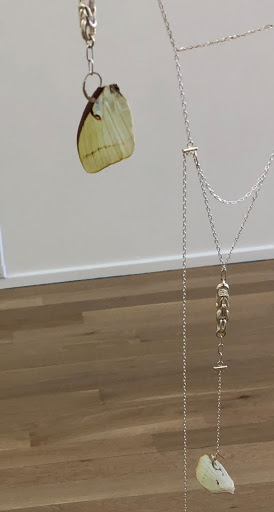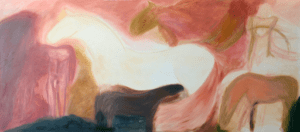

Empathy Fatigue at Andrew Rafacz raises some interesting questions. There are so many things to be fatigued about. Our ex-governor just returned home to Chicago from prison where he served a partial sentence for odious crimes, commuted by our current president. There is little surprise in one thug having empathy for another, but the existence of yet one more moronic act in the world leaves the rest of us sputtering and exhausted. Everywhere we look we see examples of people morally, intellectually and ethically slumming. A small solace is that we still have our voices.
Now the Andrew Rafacz Gallery adds another voice of a sort not previously evident on this stretch of Chicago Avenue, nestled between some great restaurants and the world class Alcala’s Western Wear store that has held the neighborhood together for decades.
Many a passersby will be able to appreciate what is visible from the window: a fifteen-foot-long painting reminiscent of cave art which presents a tranquil scene of horses, landscape and an unclothed man. It takes a moment to register that the man has no head. The artist, Dominique Knowles, states that horses can’t be dominated, but are willing to work with us. Perhaps this thinking should be applied to people as well.
Walk around the partial wall of the gallery and you will see a collaged piece that presents a man reading the newspaper. On the cover is the headline and an image about the very ex-governor previously mentioned.
The sculpture across the way by Mev Luna is neither familiar nor self-explaining. A simple structure acts as both a frame and armature to hold some jewelry-like chains. Attached to the chains like jewels are various moth wings. Thinking of the piece within the context of the exhibit title, one could consider that we are being directed to think about a crass disregard for nature, an indifference that allows us to indulge in trophy hunting and the plucking of wings off of flies. Conversely, one could consider that this is an opportunity to appreciate the beauty of nature even after it’s death, and to see that there is a vital connection between our culture and the natural world that we need constant reminding of. A sound sculpture by Jason Lazarus provides ambient noise from small machines that originally were meant to mask the private human sounds of counseling and provide a soothing element to the waiting rooms of therapists. In this instance, it provides ambient noise that is omnipresent in the gallery and which becomes just the opposite of soothing.

The topic of empathy fatigue is an important concept that deserves attention. The term was originally meant to designate the unfortunate and sometimes unavoidable exhaustion of medical workers who have been bombarded with devastating injuries or health situations and become unable to experience or express empathy to the patients they are treating. Polls show that many people in this country are now experiencing some level of a much broader empathy fatigue that extends to politics, morality, ethics and survival itself in the form of environmental concerns.
We certainly are in immediate need of a conversation about our personal situations relevant to various mental and emotional exhaustions, and a visual conversation via art is most welcome. It would be wonderful to see this topic extended in a larger, more direct and cohesive exhibit, and it is most gratifying to see the start of this discussion at the Andrew Rafacz Gallery.
Other artists included in the exhibit are Jeremy Wever, Rachel Schmidhofer and Liz Nielsen.
Margaret Lanterman
Volume 34 no 4 March/April 2020 pp 16 – 17

